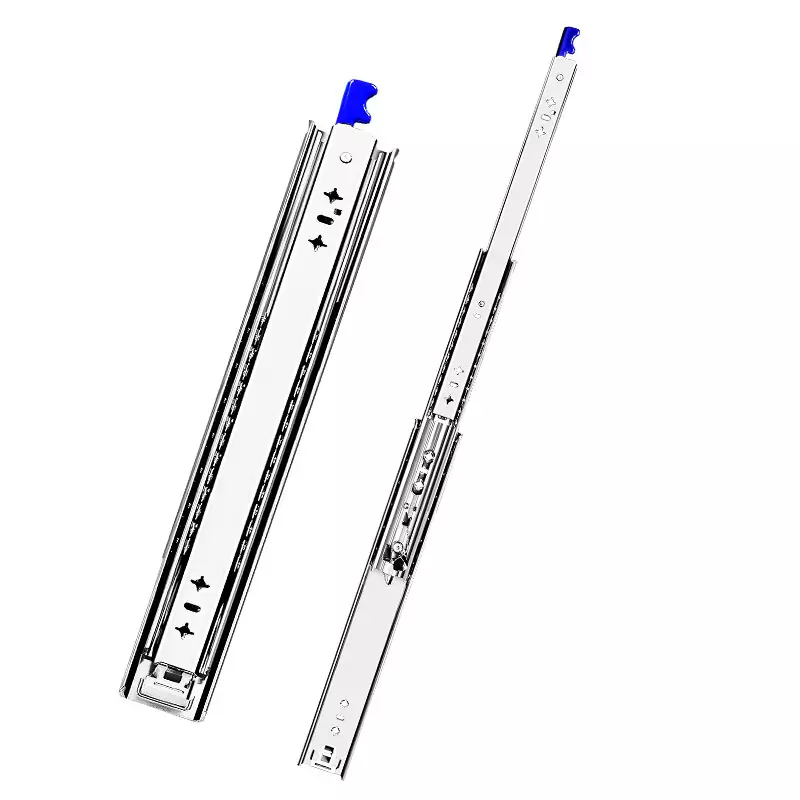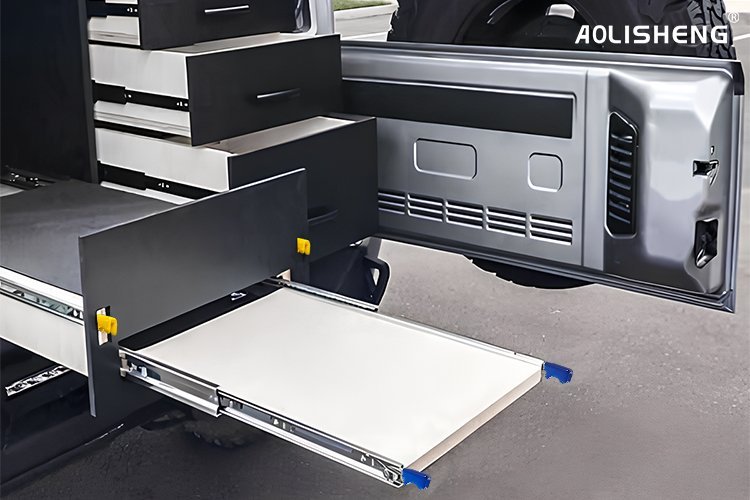heavy duty drawer slides
Looking for a different size or weight capacity? Click below to discover our full range of heavy-duty drawer slides that perfectly fit your needs!

Heavy Duty Locking Drawer Slides - D2053
265 lbs
Material: Cold-rolled steel/Q235
Slide width: 53mm
Installation thickness: 19.4±0.5mm
Slide length: 10″ to 40″
Load bearing: 18“265 lbs (120kg)
Level of travel: Full Extension
Mounting type: Side Mount
Customizable heavy-duty drawer slide size, function, hole position, color, etc.
Application Segment
vehicle modification, industrial storage, medical equipment storage, electronic products, etc.



Specific Advantages of
Heavy Duty Locking Drawer Slides
1. Enhanced Safety and Stability: Heavy duty locking drawer slides reduce the risk of accidents and equipment damage by securely fixing devices or items, particularly in high-risk or frequently moved environments.
2. Operational Convenience and Flexibility: Designed for easy locking and releasing, heavy duty locking drawer slides save time and labor costs, enhancing operational convenience and efficiency.
3. Maintenance Cost and Efficiency: Stable equipment fixation reduces repair and replacement costs caused by equipment movement or instability, prolonging equipment lifespan and reliability.
In summary, heavy duty locking drawer slides are critical in enhancing safety and stability improving operational efficiency, and ensuring long-term equipment reliability in applications requiring precise position control and secure fixation.
Our Services
MOQ Offered
We provide flexible minimum order quantities, allowing you to start small and scale up as needed.
Large Inventory
Ensuring Ample Stock for Immediate Shipment, Eliminating Wait Times for Production.
Complete Specifications
We refine various specifications of drawer slides according to different usage scenarios.
AOLISHENG produces drawer slides with standard specifications and provides customized solutions to meet your project needs.
Why Choose AOLISHENG
Rich Experience
- 15 years of industry experience.
- Extensive customization experience.
Production Automation
- Over 90% automation in production.
- Production efficiency increased by more than 10 times.
Quality Assurance
- High-quality products certified with SGS and EN standards.
- Stringent inspection department.
Mass Production
- Factory area of over 40,000 square meters.
- Daily production capacity of over 100,000 sets.
Leading Quality
- Hundreds of professional production machines.
- 5 times product accuracy.
We Look Forward To Your Contact
AOLISHENG is your trusted global partner for high-quality drawer slide production, with strategic factories worldwide and professional local service teams. Partnering with AOLISHENG ensures efficient project delivery, robust supply chains, expert technical support, and a thriving customer base.
FAQ
How do locking drawer slides work?
The locking drawer slides are the slide system with a safety feature that ensures that a drawer remains in a predetermined position when opened or closed, preventing it from accidentally sliding out or sliding in too far. The working principle of the locking drawer slides can be divided into several key parts:
1. Locking mechanism
Built-in locking device: Many locking drawer slides have a locking device integrated inside. When the locking drawer slides are fully extended to the predetermined position, the locking device automatically locks to prevent the drawer from accidentally rebounding or sliding out. This locking device usually consists of a spring and a latch.
Manual locking: Some locking drawer slides require manual operation to lock the drawer. By pressing or rotating a specific part on the slide, the user can lock or unlock the drawer.
2. Slide design
Locking grooves: The design of a locking drawer slides includes locking grooves, and when the locking drawer slides slide into these grooves, the locking device fixes the slide in the predetermined position. The locking grooves are usually designed in a specific shape to ensure the stability of the locking drawer slides.
Sliders and tracks: The internal structure of the locking drawer slides usually includes sliders and tracks. The sliders snap into the locking position in the track when the drawer is fully extended, ensuring that the drawer remains in the open position.
3. Operation method
Slide control: When the user slides the drawer, the locking device automatically unlocks and allows the drawer to slide freely on the track. After the drawer is fully closed, the locking device will reactivate to prevent the drawer from sliding out again.
Release mechanism: When the drawer needs to be retracted, some locking drawer slides provide a release mechanism. The user can press or pull a specific button or lever to unlock the drawer so that the drawer can slide back smoothly.
4. Application Scenarios
Commercial and industrial use: In occasions where the stability and safety of the drawer need to be guaranteed (such as tool cabinets, industrial equipment, etc.), locking drawer slides can effectively prevent accidental sliding out and increase the safety of use.
Home furniture: In-home furniture such as tall cabinets and kitchen cabinets, locking drawer slides can prevent the drawer from shaking during movement and improve the overall user experience.
Summary
Locking drawer slides ensures that the drawer can be stably maintained in the predetermined position when opened or closed through an integrated locking device, slide design, and operating mechanism. This design not only improves the safety of use but also enhances the stability and operating experience of the drawer. Choosing the right locking drawer slides according to your needs can effectively improve the functionality and safety of furniture or equipment.
What is the difference between locking and non locking drawer slides?
The main difference between locking and non-locking drawer slides is whether they have a locking function, which affects their stability and safety in use. Here are the key differences between the two slides:
1. Locking function
Functionality
Locking drawer slides have an automatic or manual locking mechanism that can lock the position when the drawer is fully opened or closed to prevent the drawer from accidentally sliding out or shaking.
Non-locking drawer slides have no locking mechanism, and the drawer can open and close freely when sliding. Usually, they only have a sliding function and no additional fixing function.
Safety
Locking drawer slides increase the stability of the drawer, especially suitable for high-load, heavy drawers or applications that need to ensure the stability of the drawer in the working environment.
Non-locking drawer slides are suitable for occasions where drawers need to be opened and closed frequently or the stability of the drawer position is not required.
Application scenarios
Locking drawer slides are often used in tool cabinets, industrial equipment, commercial furniture, and occasions where the drawer position needs to be stable.
Non-locking drawer slides are often used in general-purpose drawer systems such as home furniture and office drawers.
2. Design and operation
Design complexity
Locking drawer slides usually have more complex internal structures to achieve the locking function. It may include springs, latches, or lever devices.
The structure of non-locking drawer slides is relatively simple, just ensure that the slide slides smoothly, and usually, there is no additional locking device.
Operation
The locking drawer slides automatically or manually locks the drawer when fully opened or closed, and requires a specific operation or release mechanism to unlock.
The sliding operation of non-locking drawer slides is relatively direct, without additional locking and unlocking steps.
3. User experience
Advantages
Locking drawer slides provides additional security and stability, preventing the drawer from tipping over when opened or being unable to be fixed when closed.
Non-locking drawer slides are simpler to install and operate, and are suitable for occasions where additional stability is not required.
Disadvantages
Locking drawer slides may require more maintenance and adjustments, and the design of the locking mechanism may make installation and operation slightly more complicated.
Non-locking drawer slides do not have a locking function, and the drawer may slide out or shake during use, especially under heavy loads.
Summary
Locking drawer slides provide additional stability and security through an integrated locking mechanism, while non-locking drawer slides are simpler and suitable for environments where position stability is not required. Which slide to choose depends on the specific usage requirements and the requirements for safety and stability.
Is there a way to lock drawers?
Yes, there are a variety of ways to lock drawers to increase security and prevent unauthorized access. Here are some common drawer-locking methods:
1. Mechanical lock
Key lock:
Function: A lock operated by a key, usually installed on the front or side of the drawer. The user needs to insert the key and turn it to lock or unlock the drawer.
Application: Commonly found in filing cabinets, office drawers, and some home furniture.
Knob lock:
Function: Lock the drawer by turning a small knob, usually without a key, but requires a specific operation to open.
Application: Commonly used in desk drawers or small storage cabinets.
2. Electronic lock
Digital lock:
Function: Operates using a digital password, and the user enters the correct password to unlock. Some models may be equipped with a touch screen or key panel.
Application: Suitable for drawers that require high security, such as safes or high-end filing cabinets.
Fingerprint lock:
Function: Unlock by identifying the user’s fingerprint. Fingerprint data must be pre-registered.
Application: Commonly used in high-security environments, such as corporate filing cabinets or advanced home security systems.
3. Slide Locking Devices
Locking Slides:
Function: The built-in locking mechanism of the slide system automatically locks the drawer position when the drawer is fully opened or closed, preventing the drawer from accidentally sliding out.
Application: Used in tool cabinets, industrial equipment, or furniture that requires additional stability.
4. Locking Kits
Additional Lock Kits:
Function: Some existing drawers can be installed with additional lock kits. These kits usually include a lock body and a lock catch, which can be installed on existing drawers.
Application: Suitable for occasions where locking functions need to be added to existing drawers.
5. Security Devices
Locking Bars or Latches:
Function: Prevent the drawer from opening by installing a locking bar or latch inside or outside the drawer. This device usually requires manual operation to lock or unlock.
Application: Suitable for simple security needs, such as home storage cabinets or tool boxes.
Installation and Use
Choose the appropriate locking method: Choose the appropriate locking method according to actual needs. Consider security needs, ease of use, and budget.
Installation: Most locking devices require installation. Make sure to install according to the manufacturer’s instructions to ensure safety and functionality.
Regular maintenance: Check the working status of the locking device regularly, and perform necessary maintenance and lubrication to ensure the normal use of the lock.
Summary
Locking drawers can be achieved in a variety of ways, including mechanical locks, electronic locks, locking slides, additional lock kits, and safety devices. Choosing the right locking method can effectively improve the security of the drawer and prevent unauthorized access.